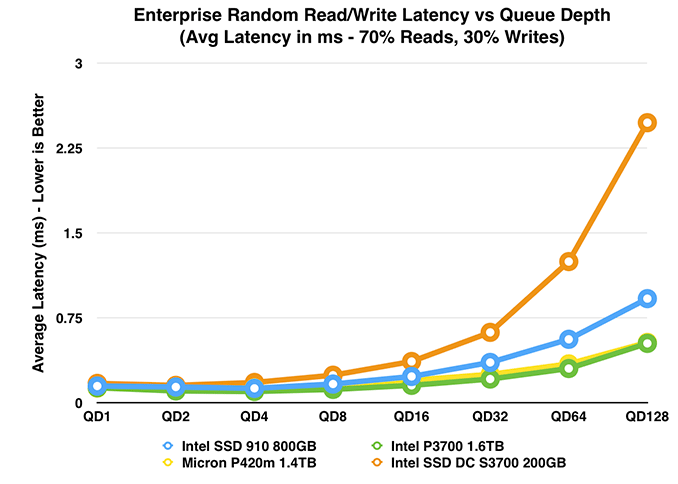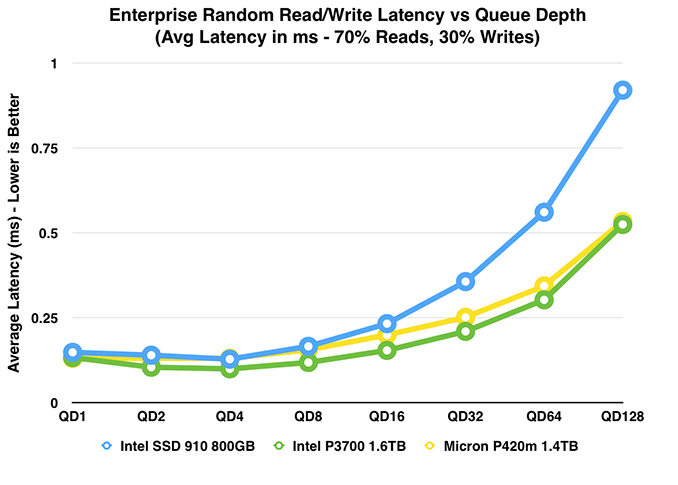Intel SSD DC P3700 Review: The PCIe SSD Transition Begins with NVMe
by Anand Lal Shimpi on June 3, 2014 2:00 AM EST- Posted in
- Storage
- SSDs
- Intel
- Intel SSD DC P3700
- NVMe
Mixed Read/Write Performance
Although our four corner testing is useful, many real world enterprise workloads are composed of a mixture of reads and writes. OLTP environments in particular tend to see a 70/30 split between reads and writes. The test below is conducted the same way as our 4KB random write test (1 sequential drive write, 1 4K-QD128 random drive write, then 3 minute test), but the actual test is 70% reads and 30% writes.

The results here look a lot like the 4KB random read results, but with a slightly different slope. The P3700 and Micron's P420m compete for top billing, but the P3700's superior random write performance and solid midrange queue depth random read performance ultimately give it the edge here.












85 Comments
View All Comments
will792 - Tuesday, June 3, 2014 - link
How do you hardware RAID these drives?With SATA/SAS drives I can use LSI/Adaptec controllers and mirror/striping/parity configuration to tune performance, reliability and drive failure recoverability.
iwod - Wednesday, June 4, 2014 - link
While NVMe only uses a third of the CPU power, it is still quite lot to achieve those IOPS. Although consumer application would / should hardly see those number in use in real life.We really need PCI-E to get faster and more lanes, the Ultra M.2 promoted by ASRock was great. Direct CPU connect, 4X PCI-E 3.0. Lots and Lots of headroom to work with. Compared to upcoming going to be standard which would easily get saturated buy the time they arrive.
juhatus - Wednesday, June 4, 2014 - link
You should really really explore how you make this bootable win8.1 drive on Z97. Is it possible or not? With M.2 support on Z97 it really should'nt be a problem?Mick Turner - Wednesday, June 4, 2014 - link
Was there any hint of a release date?7Enigma - Wednesday, June 4, 2014 - link
Why is the S3700 200GB drive being used as the comparison to this gigantic 1.6TB monster? Unless there is something I don't understand it has always been the case where the larger the drive (and more channels used) can significantly increase the performance compared to a smaller drive (with less channels). The S3700 had an 800GB drive. That one IMO would be more representative of the improvements of the P3700.shodanshok - Wednesday, June 4, 2014 - link
Hi Anand,I have some question regarding the I/O efficiency graphs in the "CPU utilization" page.
What performance counter did you watch when comparing CPU storage load?
I'm ask you because if you use the classical "I/O wait time" (common on Unix and Windows platform), you are basically measuring the time the CPU is waiting for storage, *not* its load.
The point it that while the CPU is waiting for storage, it can schedule another readily-available thread. In other words, while it wait for storage, the CPU is free to do other works. If this is the case, it means that you are measuring I/O performance, *not* I/O efficiency (IOPS per CPU load).
On the other hand, If you are measuring system time and IRQ time, the CPU load graphs are correct.
Regards.
Ramon Zarat - Wednesday, June 4, 2014 - link
NET NEUTRALITYPlease, share this video: https://www.youtube.com/watch?v=fpbOEoRrHyU
I wrote an e-mail to the FCC, called them and left a message and went on their website to fill my comment. Took me 5 insignificant minutes. Do it too! Don't let those motherfuckers run over you! SHARE THIS VIDEO!!!!
Submit your comments here http://apps.fcc.gov/ecfs/upload/begin?procName=14-... It's proceeding # 14-28
#FUCKTHEFCC #netneutrality
underseaglider - Wednesday, June 4, 2014 - link
Technological advancements improve the reliability and performance of the tools and processes we all use in our daily routines. Whether for professional or personal needs, technology allows us to perform our tasks more efficiently in most cases.aperson2437 - Thursday, June 5, 2014 - link
Sounds like once these SSDs get cheap it is going to eliminate the aggravation of waiting for computers to do certain things like loading big programs and games forever. I can't wait to get my hands on one. I'm super impatient when it comes to computers. Hopefully, there will be some intense competition for these NVMe SSDs from Samsung and others and prices come down fast.Shiitaki - Thursday, June 5, 2014 - link
No, it was not out of necessity. SSD's have used Sata because they lacked vision/ lazy, or whatever other excuse. PCI express has been around for years, as so has AHCI. There is no reason there isn't a single strap on a PCI express card to change between operating modes, like AHCI for older machines, and whatever this new thing is. All an SSD is largely a risk computer that overwhelmingly provides it's functionality using software. Msata should have never existed, if you have to have a controller anyway, why not a PCI-express? After all, SATA controllers connect to PCI-express?SSD's could have been PCI express in 2008. Those early drives however were terrible, and didn't need the bandwidth or latency, so there was no reason. They were too busy trying to get NAND flash working to bother worrying about other concerns.
Even now, most flash drives being sold are not capable of saturating Sata3 even on sequential reads. I'm going to jab Kingston again here about their dishonest V300, but Micron's M500 isn't pushing any limits either. Intel SSD's should be fast, this isn't news, they have been horribly overpriced. What is news is that the price is now justified.
Why isn't the new spec internal thunderbolt? Oh yeah, has gots to make money on licensing! Why make money producing products when it is so much easier to cash royalty checks? The last thing the pc industry needs is another standard to do something that can already be done 2 other ways, but then we need a jobs program making adapters. Those two ways are PCI-Express, and thunderbolt.
At some point the hard drive should be replaced by a PCI-express full length card that accepts NAND cards, and the user simply buys and keeps adding cards as space is required. This can already be done with current technology, no reinventing the wheel required.